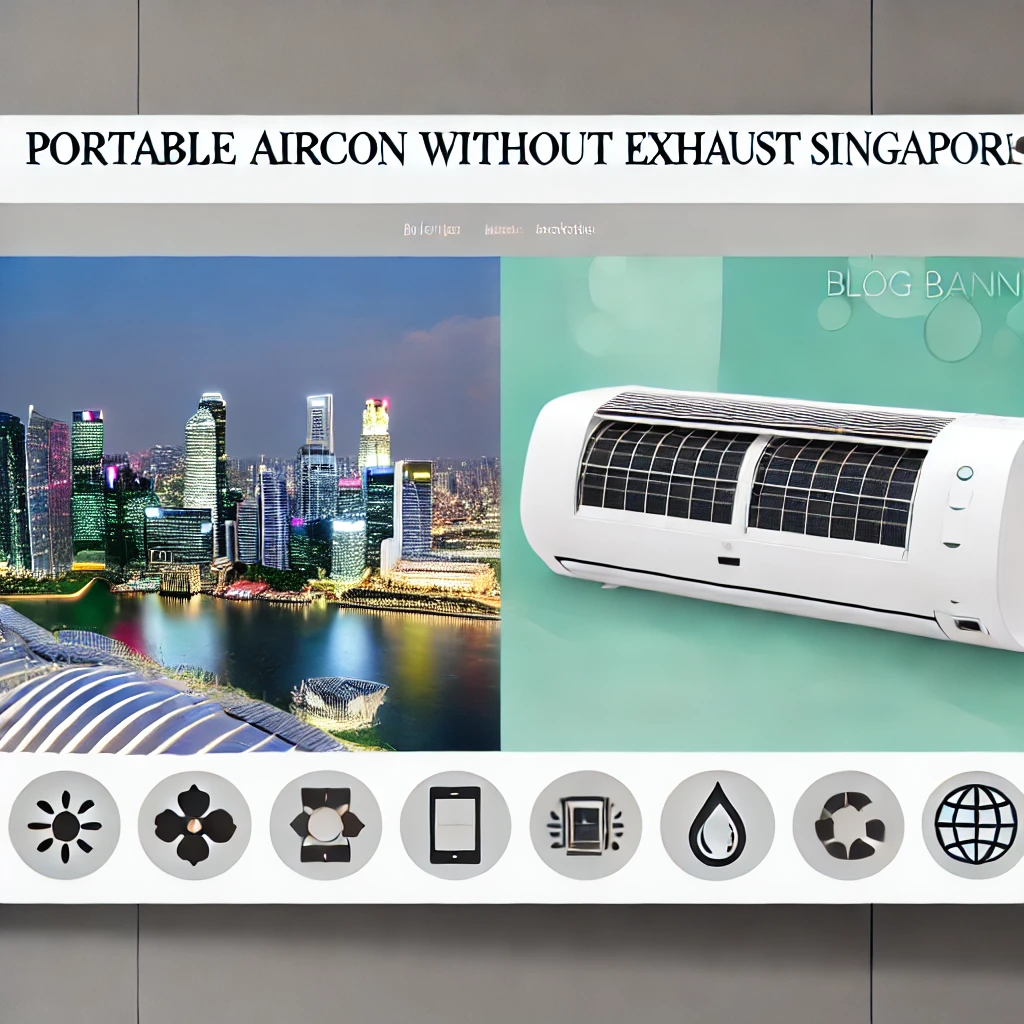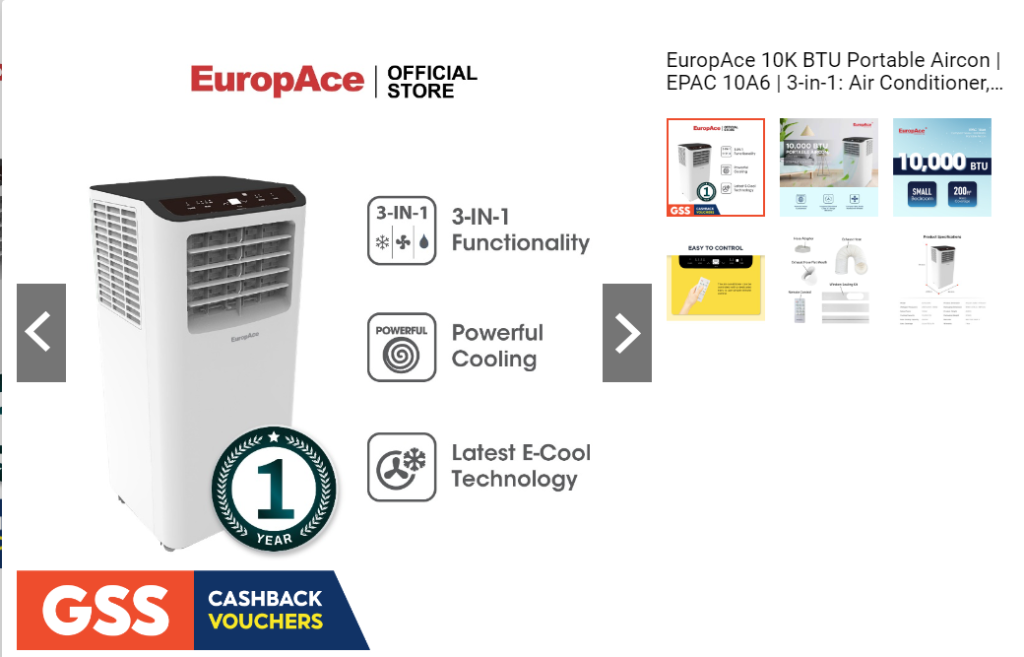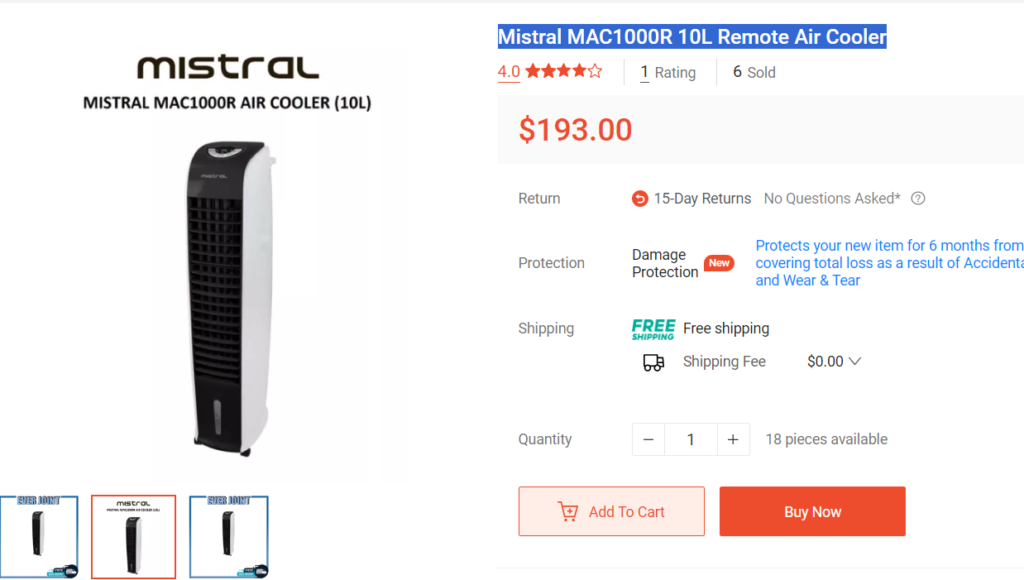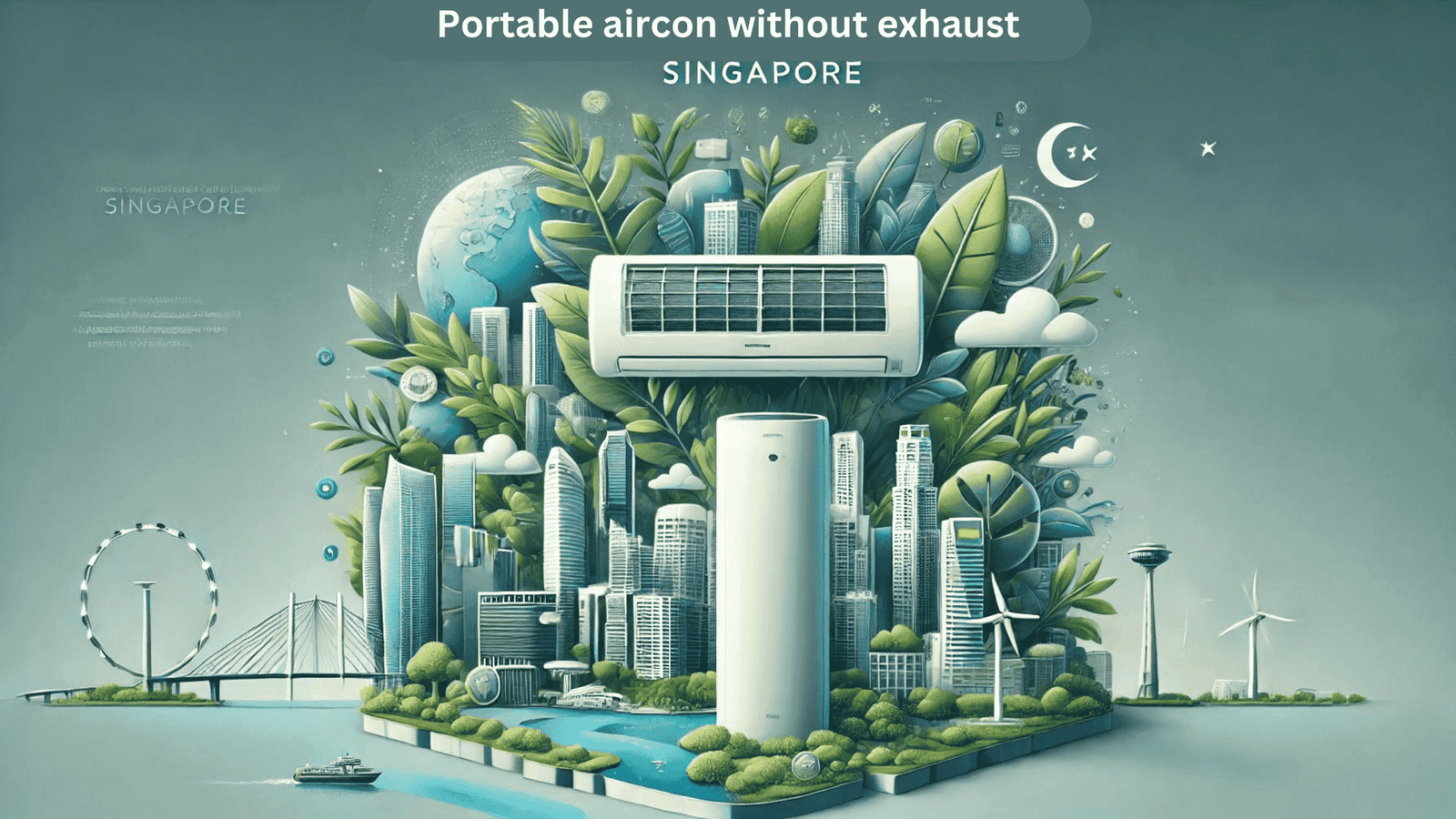Eco-Friendly and Smart Portable Aircon Without Exhaust Singapore : Revolutionizing Comfort in Singaporean Homes
Singapore’s heat can be intense, especially with temperatures rising every year. It’s a familiar scene – you’re trying to escape the sweltering weather, and the idea of a bulky, noisy traditional aircon doesn’t sound appealing. That’s where eco-friendly, smart portable aircons without exhaust come in, offering a refreshing change for Singaporean homes. Our Bluedigitaals team here tries to find best portable aircon without exhaust in Singapore for the year 2024 for your convenience.
Traditional air conditioners aren’t the best for the environment. They use a lot of electricity and refrigerants that can be harmful. In contrast, these new portable aircons are designed to be energy-efficient and eco-friendly, meaning you can stay cool without feeling guilty about your carbon footprint.
Think about it: a sleek, compact unit that blends seamlessly into your home, with smart features that let you control it with your voice or a tap on your phone. You can adjust the settings, set timers, and even monitor your energy use, all from the comfort of your couch. It’s cooling made easy and smart.
So, why stick with the old ways when you can upgrade to a smarter, greener solution? Stay cool, save money, and help the environment with these eco-friendly, smart portable aircons without exhaust – perfect for any Singaporean home.

The Rise of Eco-Friendly Cooling Solutions in Singapore
Air conditioning has come a long way since its invention. Back in the day, aircons were large, noisy, and guzzled electricity. As technology advanced, we saw improvements in efficiency and design. However, these traditional units still had a significant environmental impact, relying heavily on energy and refrigerants that contribute to greenhouse gas emissions.
Enter the new wave of eco-friendly cooling solutions. These innovative portable aircons without exhaust represent a significant shift towards sustainability. They use advanced technology to deliver powerful cooling while consuming less energy. This means lower electricity bills for you and a smaller carbon footprint for the planet.
One of the biggest advantages of these eco-friendly units is their reduced greenhouse gas emissions. Traditional air conditioners often leak refrigerants, which are potent greenhouse gases. Eco-friendly portable aircons are designed to minimize these leaks and use more environmentally friendly refrigerants. Plus, they’re typically more energy-efficient, which means they use less power and contribute less to overall greenhouse gas emissions.
In short, these eco-friendly cooling solutions offer a win-win scenario. They help you stay cool and comfortable in Singapore’s hot climate while also being kinder to the environment. It’s a smarter, greener way to beat the heat without compromising on performance.
Portable Air Cooler Singapore/Portable aircon without exhaust:
Best portable aircon Singapore 2024 :
| Product Name | Description | Price (SGD) | Where to Buy |
|---|---|---|---|
| Xiaomi Microhoo 3 In 1 Mini Air Conditioner | This compact air conditioner cools, purifies, and humidifies. It features touch screen buttons, an automatic timing function, and a bladeless design for safety. | $9.90 – $37.90 | Shopee |
| TCL TAC-10CPA/HNG 10,000 BTU Portable Aircon | TCL | Featuring patented Fogging Technology, this aircon uses eco-friendly R410A refrigerant and includes a dehumidifying function. Ideal for rooms up to 20 sqm. | $439.00 | TCL SHOP |
| EuropAce EPAC 12T3 3-IN-1 PORTABLE AIR CON | With 14,000 BTUs, this portable aircon is powerful yet compact. It includes a dual motor system, HEPA filter, and uses CFC-free refrigerant. | $499.00 | Shopee |
| Midea Portable Aircon MPPF-09CRN1 | Shopee | This aircon provides cooling and dehumidifying functions, featuring golden fin technology for durability and a reusable filter for low maintenance.9000BTU WHITE PORTABLE AIR CON | $369.00 | Shopee |
| Coolzy Portable Air Conditioner | This highly energy-efficient portable aircon consumes only 300W and is suitable for both home and office use. It can be powered by batteries, generators, or solar power. | Varies | Coolzy |
| Mistral MAC1000R 10L Remote Air Cooler | speed selection, strong air flow and Honeycomb cooling pad for even longer cool times and convenience. | $193.00 | Shopee |
| EuropAce 10K BTU Portable Aircon | EPAC 10A6 | 3-in-1: Air Conditioner | The EuropAce 10K BTU Portable Aircon EPAC 10A6 is a versatile and compact cooling unit designed to provide exceptional comfort and convenience in any home or office setting. Combining three functionalities—air conditioning, fan, and dehumidifier. | $389.90 | Shopee |
Portable Aircon Singapore 2024:


This table now provides a comprehensive overview, including the product names, descriptions, prices, and where to buy them.
Traditional Air Conditioners vs. Portable Aircons Without Exhaust in Singapore
Environmental Impact of Traditional Air Conditioners
When it comes to battling the relentless heat of Singapore, air conditioning is a must-have for many households and businesses. However, traditional air conditioners, while effective, come with a significant environmental cost.
| Feature | Traditional Air Conditioners | Portable Aircons Without Exhaust |
|---|---|---|
| Energy Consumption | High energy consumption due to refrigerant cycle | Lower energy consumption with evaporative cooling technology |
| Refrigerants | Often use harmful HFCs, which are potent greenhouse gases | Do not use harmful refrigerants, rely on water for cooling |
| Carbon Footprint | Large carbon footprint due to high energy use and refrigerant emissions | Reduced carbon footprint with less electricity use and no harmful refrigerants |
| Cooling Technology | Uses a refrigerant cycle to extract heat and expel it outside | Uses evaporative cooling, passing air over water-saturated pads |
| Environmental Impact | Significant due to high power consumption and refrigerant leaks | Minimal, with eco-friendly operation and lower energy use |
| Smart Features | Limited smart technology; some models have programmable timers | Advanced smart features like programmable timers, remote control via apps, and energy-saving modes |
| Flexibility | Fixed installation, cannot be moved easily | Highly portable, can be moved from room to room for targeted cooling |
| Convenience | Requires installation and regular maintenance | Easy setup and maintenance, with added convenience of portability |
This table provides a clear comparison between the traditional air conditioners and modern Portable Aircon Without Exhaust Singapore, highlighting their key features and environmental impacts.
High Energy Consumption
Traditional air conditioners are known for their high energy consumption. They work by extracting heat from inside the room and expelling it outside through a refrigerant cycle, which requires a lot of power. This constant draw on electricity not only leads to higher energy bills but also increases the demand on power plants. In Singapore, where the majority of electricity is generated from natural gas, this means more fossil fuels are burned, contributing to greenhouse gas emissions and climate change.
Harmful Refrigerants
Another major environmental concern with traditional air conditioners is the refrigerants they use. Many older units still rely on hydrofluorocarbons (HFCs), which are potent greenhouse gases. Even small leaks can have a large impact on global warming. Although newer models are starting to use more environmentally friendly refrigerants, the transition is slow, and many high-GWP (Global Warming Potential) refrigerants are still in use.
Carbon Footprint
The combination of high energy consumption and the use of harmful refrigerants means that traditional air conditioners have a large carbon footprint. Each unit contributes significantly to the overall emissions of a household or business. In a densely populated and warm country like Singapore, the cumulative effect is substantial, making the environmental impact of traditional air conditioners a pressing issue.
Best portable aircon Singapore:
Energy Efficiency and Eco-Friendliness of Modern Portable Aircons
In contrast to their traditional counterparts, Portable Aircon Without Exhaust Singapore offers a more eco-friendly and energy-efficient solution. These units are designed with the environment in mind, providing cooling comfort without the same level of environmental harm.
Lower Energy Consumption
Portable air conditioners without exhausts typically use evaporative cooling technology. This method consumes significantly less electricity compared to the refrigerant cycle used in traditional units. Evaporative coolers work by passing air over water-saturated pads, which cools the air through evaporation. This process requires much less energy, leading to lower electricity bills and a reduced demand on the power grid.
Environmentally Friendly Cooling
Unlike traditional air conditioners, portable aircons without exhausts do not use harmful refrigerants. This eliminates the risk of refrigerant leaks and their associated environmental damage. Furthermore, many of these units are designed to use water, a natural and abundant resource, making them a greener choice for cooling.
Reduced Carbon Footprint
By using less electricity and avoiding harmful refrigerants, modern portable air conditioners significantly reduce their carbon footprint. For environmentally conscious consumers in Singapore, this means being able to enjoy a cool home without contributing as much to global warming. Additionally, many portable units come with smart features that allow users to optimize their energy use, such as programmable timers and energy-saving modes.
Smart Features and Convenience
Modern portable air conditioners often come with smart technology that further enhances their energy efficiency. Features such as programmable timers, remote control via smartphone apps, and energy-saving modes allow users to precisely control their cooling needs. This not only improves comfort but also reduces unnecessary energy consumption.
Flexibility and Portability
One of the key advantages of portable air conditioners is their flexibility. These units can be easily moved from room to room, providing cooling exactly where it is needed. This targeted approach to cooling is more efficient than running a central air system to cool an entire home. It allows for spot cooling, which is both energy-efficient and cost-effective.
Benefits of Eco-Friendly Portable Aircons Without Exhaust
In Singapore, where the climate is consistently warm and humid, staying cool and comfortable is a top priority. Traditional air conditioning systems have long been the go-to solution, but they come with significant drawbacks, particularly concerning energy consumption and environmental impact. This is where eco-friendly Portable Aircon Without Exhaust Singapore come in, offering a more sustainable and efficient way to beat the heat. Let’s explore the key benefits of these innovative cooling solutions.
Energy Efficiency: Lower Electricity Bills
One of the standout benefits of eco-friendly portable air conditioners is their energy efficiency. Unlike traditional air conditioners, which rely on a refrigerant cycle to cool the air, these portable units often use evaporative cooling technology. This method cools the air by passing it over water-saturated pads, which requires significantly less power.
Imagine running your air conditioner for hours on end during Singapore’s hot afternoons without dreading the electricity bill. That’s the kind of relief these portable aircons provide. They consume less electricity, which translates to lower energy bills, making them an economical choice for households looking to reduce their monthly expenses. By choosing an energy-efficient model, you not only save money but also reduce the overall demand on the power grid, contributing to a more stable and sustainable energy supply.
Environmentally Friendly: Reduced Greenhouse Gas Emissions
Traditional air conditioners are notorious for their environmental impact, largely due to the refrigerants they use. Many of these refrigerants are potent greenhouse gases that contribute significantly to global warming. Additionally, the high energy consumption of these units often means more fossil fuels are burned to generate the necessary electricity, further exacerbating their environmental footprint.
Eco-friendly portable air conditioners without exhaust take a different approach. They are designed to minimize or eliminate the use of harmful refrigerants, opting instead for water-based cooling. This simple yet effective method not only cools the air efficiently but also eliminates the risk of refrigerant leaks that can harm the environment.
Moreover, the reduced energy consumption of these units means fewer greenhouse gases are emitted during power generation. By using an eco-friendly portable aircon, you’re making a conscious choice to reduce your carbon footprint and contribute to the fight against climate change. It’s a small change that can have a big impact when adopted widely.
Smart Features: Convenience and Control
Modern portable air conditioners come packed with smart features that enhance their convenience and usability. These features are designed to provide maximum comfort with minimal effort, making them a perfect fit for today’s tech-savvy consumers. Let’s delve into some of these smart features.
Voice Control
Imagine adjusting your air conditioner without having to leave your bed or couch. With voice control, this is now possible. Many eco-friendly portable aircons are compatible with smart home systems like Amazon Alexa or Google Assistant. This means you can control your unit using simple voice commands, making it incredibly convenient, especially when your hands are full or when you’re busy with other tasks. Voice control adds a layer of ease and accessibility, ensuring you can always achieve the perfect indoor climate without lifting a finger.
Mobile App Integration
Another fantastic feature of modern portable air conditioners is mobile app integration. By connecting your aircon to a smartphone app, you gain remote control over its functions. This means you can turn your unit on or off, adjust the temperature, and set timers from anywhere, whether you’re at home, at work, or on the go.
Mobile app integration allows you to create customized cooling schedules that fit your lifestyle. For instance, you can set your air conditioner to start cooling your home just before you arrive, ensuring you walk into a comfortable environment every time. This not only enhances your comfort but also ensures you’re not wasting energy cooling an empty home.
Energy Monitoring
One of the smartest features offered by these portable air conditioners is energy monitoring. Through the connected app, you can track your energy usage in real-time. This feature provides valuable insights into how much power your unit is consuming, helping you identify patterns and make informed decisions to optimize your energy use.
By monitoring your energy consumption, you can adjust your usage habits to be more efficient. For example, you might find that running the aircon at a slightly higher temperature or using it only during certain hours can significantly reduce your electricity bill without compromising on comfort. Energy monitoring empowers you to take control of your energy consumption, promoting a more sustainable lifestyle.
Conclusion:
Eco-friendly portable air conditioners without exhaust offer a range of benefits that make them an attractive option for cooling in Singapore. They are energy-efficient, helping you save on electricity bills, and environmentally friendly, reducing your greenhouse gas emissions. The inclusion of smart features such as voice control, mobile app integration, and energy monitoring provides unparalleled convenience and control, making these units a smart choice for any modern home.
By choosing an eco-friendly portable aircon, you’re not just investing in your comfort; you’re also making a positive impact on the environment. It’s a win-win situation that allows you to enjoy the best of both worlds: a cool, comfortable home and a greener, more sustainable planet.
FAQ:
Can you have a portable AC without venting?
Yes, you can have a portable AC without venting. These units typically use evaporative cooling technology, which cools the air by evaporating water, eliminating the need for exhaust vents. They are energy-efficient, eco-friendly, and easy to move, making them ideal for cooling individual rooms or spaces.
Do all portable air conditioners have exhaust?
No, not all portable air conditioners have exhaust vents. Some models use evaporative cooling technology, which cools the air without the need for exhaust vents, making them more flexible and eco-friendly.
Can I use a portable air conditioner in a room without window access?
Yes, you can use a portable air conditioner in a room without window access by opting for an evaporative cooler or a portable AC designed without an exhaust vent. These models do not require window access for venting.
How much electricity does portable AC use in Singapore?
The electricity usage of a portable AC in Singapore typically ranges from 500 to 1,500 watts per hour,average of 1.176 kWh of electricity per hour, depending on the model and its cooling capacity. Energy-efficient models can help reduce overall electricity consumption.
Do ventless air conditioners work?
Yes, ventless air conditioners, also known as evaporative coolers, work by using water evaporation to cool the air. They are effective in dry climates and can provide efficient cooling for small to medium-sized spaces without the need for exhaust vents.
What is the difference between vented and ventless portable air conditioners?
Here is a table summarizing the differences between vented and ventless portable air conditioners:
| Feature | Vented Portable Air Conditioners | Ventless Portable Air Conditioners (Evaporative Coolers) |
|---|---|---|
| Cooling Method | Uses a refrigerant cycle to cool the air | Uses water evaporation to cool the air |
| Setup | Requires an exhaust hose to vent hot air outside, usually through a window or wall | Does not require an exhaust hose, offering more flexible placement |
| Effectiveness | Effective in both dry and humid climates, providing strong cooling power | Best suited for dry climates as they add humidity to the air, less effective in humid environments |
| Installation Requirements | Needs window or wall access for venting | No specific installation requirements, can be placed anywhere |
| Energy Consumption | Typically higher due to the refrigerant cycle | Generally lower energy consumption |
| Environmental Impact | Can use harmful refrigerants | More eco-friendly, using water for cooling |
| Humidity Impact | Does not add humidity to the air | Increases humidity, which can be beneficial in dry climates but not in humid ones |
| Portability | Less portable due to the need for venting | Highly portable and easy to move |
| Maintenance | Requires maintenance of refrigerant and exhaust hose | Requires regular refilling of water and cleaning of cooling pads |
Which is better, AC or portable AC?
Here is a table summarizing the key points comparing traditional air conditioners (AC) and portable air conditioners (portable AC):
| Key Points | Traditional Air Conditioner (AC) | Portable Air Conditioner (Portable AC) |
|---|---|---|
| Cooling Power | More powerful, suitable for larger spaces | Less powerful, ideal for smaller areas |
| Installation | Requires professional installation, permanent modifications | Easy setup, no professional installation needed |
| Portability | Fixed in one location | Highly portable, can be moved between rooms |
| Cost | Higher initial cost and installation fees | Generally lower upfront cost, no installation fees |
| Noise Levels | Quieter operation with outdoor compressor | Noisier due to indoor compressor and fan |
\

